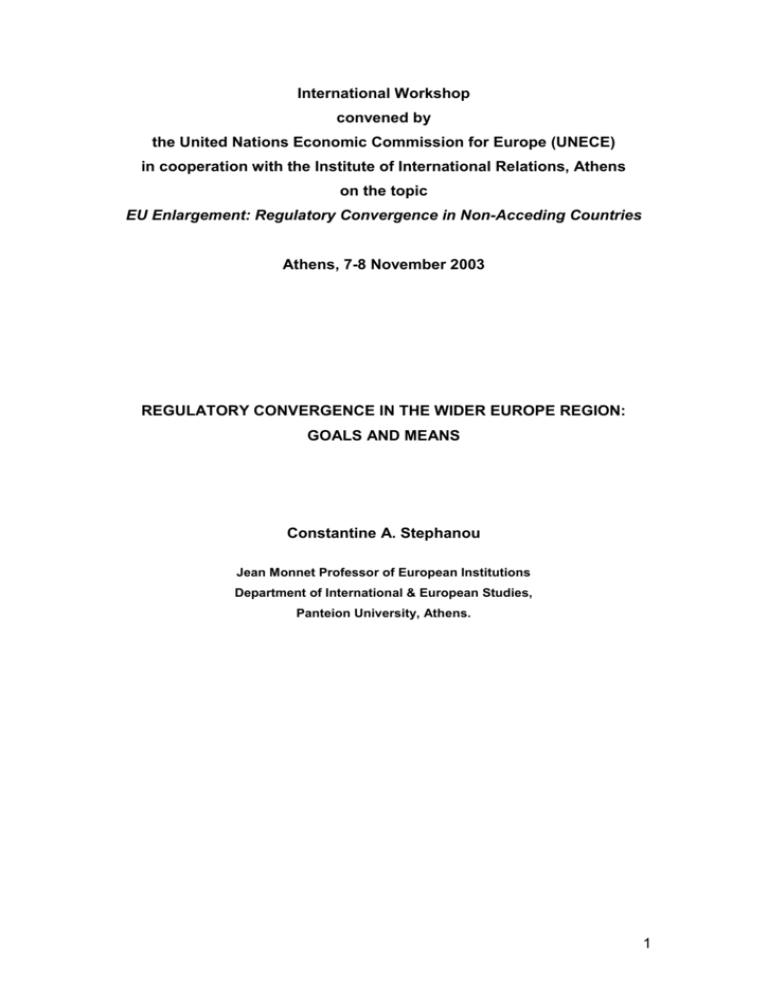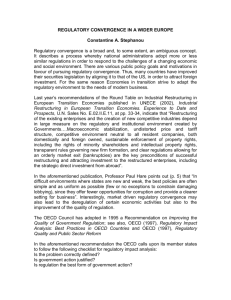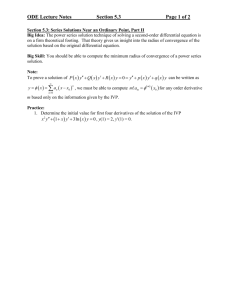Goals and means of regulatory convergence
advertisement

International Workshop convened by the United Nations Economic Commission for Europe (UNECE) in cooperation with the Institute of International Relations, Athens on the topic EU Enlargement: Regulatory Convergence in Non-Acceding Countries Athens, 7-8 November 2003 REGULATORY CONVERGENCE IN THE WIDER EUROPE REGION: GOALS AND MEANS Constantine A. Stephanou Jean Monnet Professor of European Institutions Department of International & European Studies, Panteion University, Athens. 1 1. The conceptual framework Regulatory convergence is a broad and, to some extent, an ambiguous concept. Regulatory convergence describes a process whereby national lawmakers adopt more or less similar regulations in order to respond to the challenges of a changing economic and social environment. It is possible to distinguish three forms of regulatory convergence: Voluntary, semi-voluntary and mandatory. 1.1. Voluntary convergence Countries facing the same challenges adopt similar responses, without being bound by international obligations. Voluntary convergence can be marketinduced or spontaneous, inspired, however, by the legal practices of other countries (cross-fertilisation). Market - induced convergence in the area of economic regulation There are examples of positive convergence resulting from the introduction of new legislation or upgrading of existing legislation. Thus, since the end of the Second World War developed countries - and the EC for that matter - have introduced antitrust legislation largely inspired from the corresponding US legislation, dating back to the Sherman Act of 1890. Moreover, many developed countries have upgraded their securities legislation under the influence of evolving US legislation, such as the Sarbanes - Oxley Act of 2002 following the Enron debacle. On the other hand, a trend towards negative convergence is perceptible in the case of developing countries and transition economies which strive to adapt the regulatory environment to the needs of modern business, by eliminating administrative “red tape”. 2 Spontaneous convergence in areas other than economic regulation Welfare states have adopted similar responses to challenges such as the demographic challenge (ageing of populations) posed to the sustainability of pensions and health systems. In the EU, regulatory convergence in some policy areas which remain within the competence of member States is enhanced by the exchange of good practices in the context of the “open method of cooordination”, also known as “Lisbon method”. 1.2. Semi-voluntary convergence Semi-voluntary convergence can be attributed to the activities of international organisations (intergovernmental or non-governmental). States are free to adapt their conduct to the requirements of international organisations but, in actual practice, they could be penalised if they chose to ignore them and behave as “free riders” (see Section 2). Semi-voluntary convergence is reflected in the following cases: the activities of some international standard - setting organisations, the “conditionalities” imposed by some international organisations, the prerequisites for membership of international organisations. With respect to semi-voluntary convergence resulting from the activities of international standard - setting organisations, the cases of international labour standards and international financial and accounting standards are the most evident. Labour standards have been adopted since the end of the First World War by the International Labour Organisation (ILO), in the form of international labour conventions and recommendations setting minimum standards of protection of workers and employees. In the financial field, regulatory convergence is initiated by instruments of “soft law” (recommendations, codes of conduct etc.). Financial and accounting standards are a more recent phenomenon. They are adopted by international 3 bodies such as the Basle Committee on Banking Supervision, the Financial Action Task Force (FATF), the International Accounting Standards Board (IASB) etc. The instruments of “soft law” are transposed into domestic law by the relevant regulatory authorities and become mandatory. With respect to “conditionalities” imposed by some international organisations, the most prominent examples are those related to economic policy imposed to State borrowers by the IMF, as well as the covenants related to project financing by the World Bank. Conditionalities are also instrumental to EU external relations. Political and economic conditionalities have been incorporated in association agreements with developing countries, partnership and cooperation agreements with transition economies, stabilisation and association agreements with countries of the Western Balkans etc. With respect to the prerequisites for membership of international organisations, the two most hotly debated cases are those related to EU and WTO accession. As far as EU membership is concerned, aspiring members are required not only to take up the Community “rule book”, commonly known as “acquis communautaire”, but also to comply with the so-called Copenhagen criteria, i.e. a set of political and economic conditionalities. Progress by candidate states is monitored by the European Commission which is required to submit a progress report each year. As far as WTO membership is concerned, to which many non-acceding to the EU countries aspire, the issue is dealt with separately in section 4. 1.3. Mandatory convergence Mandatory convergence can also be attributed to the activities of some international organisations. Thus, Article 2.4 of the WTO agreement on technical barriers to trade (TBT) provides that “Where technical regulations are required and relevant international standards exist or their completion is imminent, Members shall use them, or the relevant parts of them, as a basis for their technical regulations…”. Technical standards are adopted in the 4 context of international organisations, such as the United Nations Economic Commission for Europe (UNECE), the International Telecommunications Union (ITU), the International Standardisation Organisation (ISO) etc. Participation in supranational law-making organisations entails the compulsory acceptance of norms enacted by these organisations. The classic example is the approximation of national laws under EC treaty provisions. Approximation of laws entails the adoption of standard-setting directives by EU institutions and their compulsory implementation by the member States. Approximation aims at combating distortions in the Single European Market, but also at improving the welfare of citizens. EU norms in the area of consumer safety, social and environmental protection usually take the form of essential requirements and minimum standards of protection. The establishment of the Single European Market has been based on the socalled new approach involving on the one hand the mutual recognition of national norms of member States and, on the other, approximation of laws where absolutely necessary. Under the Single Market Program, 300 directives aimed at eliminating market distortions and setting minimum standards were adopted. In more recent times, directives have served to regulate banking, insurance and services of “general economic interest”, such as public utilities. Thus, in the EU area, domestic market regulation largely emanates from EU institutions. Another case of mandatory convergence, although of a more flexible nature, arises in the context of bilateral agreements. Thus, article 53 of the Partnership and Cooperation Agreement between the EC and Russia lays down rules regarding competition law, including state aids, state monopolies and state enterprises; article 54 confirms the commitments under the international conventions for the protection of intellectual property and, finally, under article 55, Russia undertakes to progressively ensure the compatibility of its legislation to that of the EU, in practically all the areas where the EU has enacted legislation. 5 2. The issue of regulatory competition and “free riders’ 2.1. The policy dilemmas Non-participation in international trade regimes by States which are referred to as “free riders”, as well as regulatory competition in the areas of social and fiscal policy have been extensively discussed in academic literature. Our purpose here is to discuss the dilemmas to which policy-makers are confronted and the implications of policy options. Such dilemmas can be solved by requesting expert advice, in the form of regulatory impact analysis. The conclusions of such analyses vary, according to the levels of economic and social development. In the EU, the basic motive behind regulatory convergence - in the form of approximation of national laws, as already mentioned, - is the need to avoid regulatory competition among member States (See F. Scharpf, Governing in Europe, Oxford, 1998, pp. 84 et seq. (109). Frequently, however, there is disagreement as to whether action in the form of approximation of laws is desirable or whether member States should be left to respond freely to market forces. Moreover, as already pointed out, where regulation is deemed necessary, it usually takes the form of essential requirements or minimum standards of protection. 2.2. Social Policy The British opting-out from social policy from 1993 to 1999 was perceived by EU partners as a form of social dumping. Maintaining low levels of social protection in order to attract foreign direct investment may be a public policy option in non-EU countries. Staying out from the international labour conventions may entail, however, negative implications regarding access to the US and EU markets. Thus, the benefits of the Generalised System of Preferences (GSP) may be refused to countries which do not implement the 6 fundamental social rights embodied in the 1998 ILO Declaration; alternatively, additional benefits may be provided to countries which observe the said principles. In the context of the wider Europe region, labour cost differentials between countries acceding to the EU and non-acceding countries are bound to grow as a result of the adoption by the former of EU labour standards. Thus, nonacceding countries may improve their competitive position by staying out from the EU. However, it would be a mistake for non-acceding countries to rely exclusively on labour intensive industries for their economic growth. 2.3. Fiscal policy There is disagreement among economists on how to deal with fiscal competition. Some favour market - induced convergence, while others worry about a possible “race to the bottom” and recommend international cooperation for the elimination of tax havens. Fiscal policy is an area where unanimity is required under the EC Treaty for the adoption of approximation directives. There is, furthermore, opposition to the granting of exemptions or opt-outs, because it is felt that countries exempted from harmonisation would very soon attract the funds of non-residents. Moreover, during the elaboration of the directive on the taxation of the proceeds from savings, some member states insisted that non EU States - and indeed Switzerland - should also be bound by means of a bilateral agreement. A compromise was finally reached by the Greek presidency of the Council last spring (2003). Maintaining low levels of taxation in order to attract foreign direct investment may be a public policy option in the EU, as well as in non-EU countries. Thus, countries of the UNECE region provide tax-free zones or very favourable tax regimes for corporations, which do not necessarily discriminate between resident and non-resident corporations or foreign-owned and locally-owned resident corporations. Studies commissioned by business associations suggest, however, that in addition to taxation, flexible labour practices and, 7 more generally, a favourable regulatory environment, have played a role in attracting foreign direct investment to these countries. In 1998 the OECD issued a report and recommendations on Harmful tax competition. To be sure, there is a strong case for allowing developing countries and transition economies to use tax incentives in order to attract investment in key economic sectors. An effective means for attracting foreign direct investment may still be, however, the functioning of a stable and transparent fiscal system. 3. Improving the quality of the regulatory environment Last year’s recommendations of the Round Table on Industrial Restructuring in European Transition Economies published in UNECE (2002), Industrial Restructuring in European Transition Economies. Experience to Date and Prospects, U.N. Sales No. E.02.II.E.11, at pp. 33-34, indicate that “Restructuring of the existing enterprises and the creation of new competitive industries depend in large measure on the regulatory and institutional environment created by Governments….Macroeconomic stabilization, undistorted price and tariff structure, competitive environment neutral to all resident companies, both domestically and foreign owned, sustainable enforcement of property rights, including the rights of minority shareholders and intellectual property rights, transparent rules governing new firm formation, and clear regulations allowing for an orderly market exit (bankruptcies) are the key preconditions of successful restructuring and attracting investment to the restructured enterprises, including the strategic direct investment from abroad”. Moreover, in his contribution to the aforementioned round table, Professor Paul Hare points out (p. 5) that “In difficult environments where states are new and weak, the best policies are often simple and as uniform as possible (few or no exceptions to constrain damaging lobbying), since they offer fewer opportunities for corruption and provide a clearer setting for business”. Thus, 8 the quality of the regulatory environment plays an important role in attracting or deterring foreign investment. The OECD Council has adopted in 1995 a Recommendation on Improving the Quality of Government Regulation; see also, OECD (1997), Regulatory Impact Analysis: Best Practices in OECD Countries and OECD (1997), Regulatory Quality and Public Sector Reform In the aforementioned recommendation the OECD calls upon its member states to observe the following checklist of questions for regulatory impact analysis: Is the problem correctly defined? We would add that the problem needs to be defined not in abstracto but in the socio-economic context of the relevant country. Policies which are being successfully implemented by developed countries may not be suitable for developing countries. A classic example is that of the international patent system. The system is best suited for developed countries; nevertheless, developing countries are advised to provide protection for foreign-owned patents, if they want to attract foreign investment. The balance is difficult to strike where patent protection collides with public health goals. In the current multilateral trade negotiations (Doha Round) developing countries lead by India, Brazil and South Africa obtained a favourable interpretation of the relevant provisions of the TRIPS agreement on the issue of pharmaceutical patents. Is government action justified? Alternatives such as self-regulation are frequent in the area of industrial relations. They need, however, to rely on a solid legal framework. Is regulation the best form of government action? Alternative forms of action, such as incentives are increasingly applied as policy instruments. Thus for example, eligible for financial support are 9 enterprises which comply with certain criteria, such as ISO certification for goods or services. Is there a legal basis for regulation? Moreover, it is necessary to monitor the compatibility of the regulation with the Constitution. Regulations may restrict property rights, the freedom of enterprise etc. It is also necessary to check their compatibility with international obligations. Thus for example, member States of the Council of Europe should abide by the obligations arising from Protocol no. 1 to the European Convention on Human Rights ensuring the protection of private property. In the field of intellectual property rights, the member states of WTO should ensure that domestic regulation is compatible with the TRIPS agreement. Member States of OECD should ensure that national regulations are compatible with the decisions adopted by the Ministerial Council on foreign direct investment (national treatment). What is the appropriate level (or levels) of government for this action? In some areas it may be expedient to entrust the implementation of regulations to sub-national entities or independent regulatory authorities. The advantages of independent regulatory authorities have been extensively discussed in recent years. Do the benefits of regulation justify the costs? Implementation of regulations entails setting up implementing institutions with substantial cost implications. Often, institutions are established without ensuring adequate financial resources for the performance of their tasks. Is the distribution of effects across society transparent and, we might add, does it comply with the principle of equal treatment? Transparency, as well as equality of chances, are of paramount importance in order to ensure a level playing field for economic players. 10 Is the regulation clear, consistent, comprehensible and accessible to users? The most frequent practical issue relates to the inconsistency of various rules. Regulators should clarify to what extent preexisting legislation is repealed by new legislation and should include transitional arrangements for pending administrative procedures. The EU and most member States have undertaken efforts aimed at the simplification and codification of substantive rules, as well as procedures for granting approvals, permits etc. Have all interested parties had the opportunity to present their views? In addition to parliamentary scrutiny, democratic governance requires effective consultation during the preparatory phase of legislation (prelegislative phase). Although formal consultations may take place in bodies such as Economic and Social Committees, effective consultation or dialogue with interested parties (stakeholders) depends on whether the latter are properly organised in the country concerned. Thus, in many countries, consumers or users of public utilities are not properly organised. In some developed countries various forms of coregulation have been tested, involving interested parties in the implementation phase, for example by entrusting them with the adoption of codes of good conduct. How will compliance be achieved? There are two issues. The first is compliance by the citizens. The second is compliance by the administration. A typical problem in many developing countries is the discretionary power of the administration and the resulting corruption. Such power can be contained by setting objective criteria and timelimits for administrative action. Some of the aforementioned principles are embodied in the well-known concept of the Rule of Law. Central to this concept are the principle of legality - i.e. the requirement of a legal basis for government regulation and taxation, the obligation to motivate administrative acts, the principles of equal 11 treatment, proportionality, legal certainty and protection of legitimate expectations, non-retroactivity of taxation. Moreover, in enacting legislation, federal states - and the EU for that matter have to observe the principle of subsidiarity. Under article 5 of the EC treaty this principle entails that the Community shall take action “only if and in so far as the objectives of the proposed action cannot be sufficiently achieved by the member States and can therefore, by reason of the scale or effects of the proposed action, be better achieved by the Community”. Although this wording relates to the appropriate level of primary legislation, the principle of subsidiarity may also be applied in respect of implementing legislation. 4. Regulatory prerequisites for membership of WTO 4.1. Nature of adjustments In some transition economies there is a on-going discussion on the merits of acceding to the basic international trade regime, namely the WTO. Accession to WTO entails the abandonment of some of the aforementioned policy options. Countries have to adjust not only their foreign trade legislation, but also their domestic legislation in areas such as taxation, technical standards, sanitary and phytosanitary standards, government procurement, investment laws in accordance with the TRIMS agreement, intellectual property rights in accordance with the TRIPS agreement, etc. Special difficulties arise in relation to the commitments regarding State trading enterprises. As pointed out by Ognitsev / Jounela / Tang in UNCTAD (2001), WTO Accessions and Development Policies, U.N. Sales No. E.02.II.D.19, at pp. 201-2, under Article XVII of GATT the criterion is not ownership but rather how and under what conditions the enterprise operates. Thus, privatising an enterprise, transforming it into a joint stock company or having it operate within special funds does not change its position as a state trading enterprise if it still enjoys exclusive or special rights or statutory or constitutional powers 12 through which, with its purchases or sales, it influences the level of imports or exports. State-owned enterprises which do not enjoy special rights or privileges do not fall within the disciplines of Article XVII. Moreover, WTO members have paid special attention to all kinds of monopolies that the acceding countries may have in the areas of production, distribution and/or foreign trade - relating these questions often to state trading but also to government procurement, state subsidies etc. Commitments are included in a country’s accession protocol. 4.2. Capacity to fulfil obligations Newly acceding countries, including transition economies, are required to comply with WTO rules upon accession or within a very short period of time. As observed by the former Hungarian Ambassador to the WTO, Peter Naray, in the aforementioned UNCTAD publication (pp. 148-9), their political, social, institutional problems are routinely disregarded. “Systemic inconsistencies” with multilateral rules and obligations as was the case with some Eastern European countries when the joined GATT in the 1960’s and 70’s cannot be sustained. Because of the great outside pressure to undertake liberal commitments and the substantial interest of acceding countries in WTO accession, they accept the accession conditions even if they are not sure of being able to implement them fully. Therefore, there is a danger that the present accession policy will produce members which are WTO compatible only on paper. Naray (p. 150) rightly points out that acceding countries should not be requested to accept more commitments than they can fulfil. Not liberalisation but sustainable liberalisation should be the objective. Transition periods should be granted when they are required in a specific accession case. Moreover, an analysis covering the challenges to be expected during the implementation phase, including the impact of accession on development, should be prepared by an organisation other than the WTO. The UNECE could for example be entrusted with this task in the case of transition economies aspiring to become members of the WTO. 13 In conclusion, regulatory convergence is, in some areas, spontaneous or market - induced and, in other areas, it is related to participation in international or supranational organisations. International organisations such as the UNECE have played an important role in standard - setting and have contributed thereby to regulatory convergence in the wider Europe region. Regional organisations could also provide expertise to transition economies for performing regulatory impact analysis and assist them in their preparations for accession to the WTO. ******* 14 15









